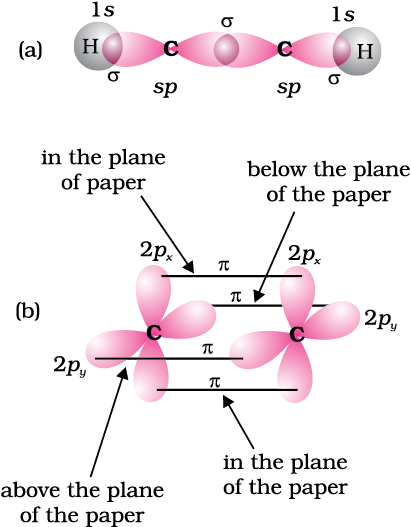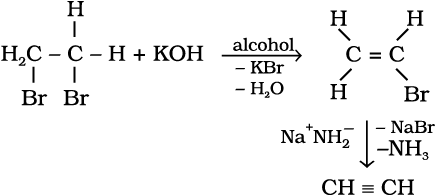Ethyne is the simplest molecule of alkyne series. Structure of ethyne is shown in Fig. 13.6.
Each carbon atom of ethyne has two sp hybridised orbitals. Carbon-carbon sigma (σ) bond is obtained by the head-on overlapping of the two sp hybridised orbitals of the two carbon atoms. The remaining sp hybridised orbital of each carbon atom undergoes overlapping along the internuclear axis with the 1s orbital of each of the two hydrogen atoms forming two C-H sigma bonds. H-C-C bond angle is of 180°. Each carbon has two unhybridised p orbitals which are perpendicular to each other as well as to the plane of the C-C sigma bond. The 2p orbitals of one carbon atom are parallel to the 2p orbitals of the other carbon atom, which undergo lateral or sideways overlapping to form two pi (π) bonds between two carbon atoms. Thus ethyne molecule consists of one C–C σ bond, two C–H σ bonds and two C–C π bonds. The strength of C≡C bond (bond enthalpy 823 kJ mol-1) is more than those of C=C bond (bond enthalpy 681 kJ mol–1) and C–C bond (bond enthalpy 348 kJ mol–1). The C≡C bond length is shorter (120 pm) than those of C=C (133 pm) and C–C (154 pm). Electron cloud between two carbon atoms is cylindrically symmetrical about the internuclear axis. Thus, ethyne is a linear molecule.

Fig. 13.6 Orbital picture of ethyne showing
(a) sigma overlaps (b) pi overlaps.
1. From calcium carbide: On industrial scale, ethyne is prepared by treating calcium carbide with water. Calcium carbide is prepared by heating quick lime with coke. Quick lime can be obtained by heating limestone as shown in the following
reactions:
 (13.55)
(13.55)
 (13.56)
(13.56)
Calcium
carbide
 (13.57)
(13.57)
2. From vicinal dihalides : Vicinal dihalides on treatment with alcoholic potassium hydroxide undergo dehydrohalogenation. One molecule of hydrogen halide is eliminated to form alkenyl halide which on treatment with sodamide gives alkyne.


© 2025 GoodEd Technologies Pvt. Ltd.